ODSP recipients calling for help, exploring assisted dying
Posted September 2, 2020 3:14 pm.
Last Updated September 2, 2020 6:48 pm.
COVID-19 has proven itself as not an equal opportunity crisis, revealing cracks in the system that leave the most vulnerable exposed.
Low income and racialized communities have been hit the hardest, but there is another group that feels abandoned and ignored – people with disabilities.
There are fears some with disabilities are considering assisted dying as a last resort.
Kim is a recipient of Ontario Disability Support Program (ODSP) and says her life has been “pure hell” during the pandemic. CityNews has honoured Kim’s request not to use her last name.
“It’s like I’m being punished for being born disabled, like I committed some kind of crime,” said Kim.
She was born with digestive ailment and has had most of her intestines removed. Kim needs a feeding tube and survives on ODSP payments.
A single person with disabilities in Ontario can earn a maximum of $1,169 in social assistance.
Kim also receives a food subsidy of $250 a month due to health issues, giving her just over $1,400 per month to live on.
She pays $1,000 to rent a 300-square foot RV in a trailer park, leaving her with $421 for all other expenses.
Kim says she usually never has any extra money left over and often doesn’t make it to the end of the month for food.
Her story is echoed by many on social media.
One man, Patrick Doherty, tweeted last month that after dropping off his rent cheque he only had $2 a day to spend on food for the rest of the month.
Just dropped off my rent money .On ODSP that leaves me 69 dollars 2 dollars a day any food suggestions or than Ramen noodles.
— Patrick J Doherty (@PatrickJDohert4) August 1, 2020
A lack of proper food is a common concern among people on ODSP.
“Some learn to get potatoes and margarine so at the end of the month, it’s called the potato diet and it’s one potato a day for the last two weeks,” Kim explained.
Another woman said after paying her bills this month, she is left with just under $4.
“This is because I chose my medication which I cannot live without for mental health issues,” read her tweet.
This is because I chose my medication which I cannot live without for mental health issues.
— Quizzical System (@QuizzicalSystem) September 2, 2020
Advocates have been fighting to raise ODSP for years. In 1995, when Mike Harris was premier, he cut it by 21 per cent.
A chart provided by the current government shows in 1998, a person with disabilities could receive up to $930 a month. Twenty-two years later, that amount has gone up by just $239, which works out to 65 cents more a day.

A graph shows how much the payments to a single person with disabilities have increased since 1998. Information courtesy of the Ontario government.
Trevor Manson with the ODSP Action Coalition said social assistance recipients are getting poorer every year, explaining “because rent goes up every year, we’re forced to make more out of less.”
Before the last provincial election, Kathleen Wynne’s Liberals promised to raise ODSP by three per cent a year for three consecutive years.
The Ford government cancelled the increases in 2018 and raised payments once by 1.5 per cent. According to government statistics, there are 380,000 ODSP cases at a cost of $5.3 billion a year.
The COVID-19 pandemic has made things even more dire for those with disabilities.
A Stats Canada survey released last week found 61 per cent of people with disabilities are struggling to pay rent or buy medications as the cost of living goes up.
Even more chilling is that some are talking online about applying for Medically Assisted Dying (MAID).
One woman on Twitter said she enrolled because she “can no longer afford to live, nor can I afford the food and medicine I need to get better.”
I've enrolled in MAID, seeing as I can no longer afford to live, nor can I afford the food & medicine I need to get better. @fordnation is killing me slowly, but not just me, which is why I had to wait over an hour the first time I called. @OntHumanRights #ODSP #ODSPoverty
— alysm745 (@alysm745) August 21, 2020
Kim says she knows of more than 50 people who have applied for MAID while some, she says, are taking other routes.
“I’ve lost six friends to suicide since [the beginning] of COVID,” said Kim.
It is hard to know if applications to MAID have increased since the beginning of the pandemic, particularly among people with disabilities.
In an email, the federal government stated those numbers won’t be available until the spring – meaning there may be no red flags until then.
“They don’t want to live this way anymore, there is no safety net at all for people that are disabled,” said Kim.
Kim admits she has thought about applying for MAID herself. She says her landlord is evicting her because he can get an additional $400 a month on AirBnB and she can’t afford that. Paying $1,400 in rent would leave her with $21 a month for food and all expenses.
She says even the shelters are full and she doesn’t know where she will go next.
When asked how she would describe her life on ODSP, Kim says, “I have no dignity left, I don’t like to go anywhere or have anyone see me … I don’t feel like I’m worth anything to anyone anymore.”
Premier Doug Ford has repeatedly said there is no money to increase monthly ODSP payments and recently suggested they should get a job.
“The best way to help people in Ontario Works or ODSP, if they’re healthy and they’re able to work, get them a job, help get them a job,” he said back on August 6.
Advocates say it is extremely difficult, if not impossible, for many people with disabilities to find employment and even if they could, their earnings are clawed back.
Ford also said those who collect ODSP, have part-time jobs and are able to collect CERB, are “actually up a few hundred dollars, not down.” He added, “I understand people are struggling, I get it.”
If those on ODSP payments want to collect the Canadian Emergency Response Benefit (CERB), the funds are treated in a similar manner to employment earnings, making them subject to taxes.
It could also technically make them financially ineligible for ODSP income support.
If someone qualifies for CERB and they switch to receiving those payments, they will also have to re-qualify for ODSP when CERB ends.








